Custom Design
Is your great business idea mired in the planning stage and never seems to make it to reality? You’re not alone. Most business owners and marketing teams wrestle with the disconnect between having fantastic ideas and actually being able to implement them effectively.
A strategic roadmap is your company’s GPS, which leads you from where you stand today to where you need to be tomorrow. Without this key map, even the most enthusiastic entrepreneurs are spinning their wheels, reacting to circumstances rather than making deliberate actions that create meaningful growth.
This page will take you through what you need to know to create and implement effective strategic roadmaps. We’ll discuss the basics, drill down into tested models, and provide you with a step-by-step guide to turn your vision into measurable outcomes.

A strategic roadmap is an illustrated planning guide that sets out how your organization will reach its long-term objectives. It is a metaphorical bridge connecting your existing business status with your desired future standing.
In contrast to the dusty business plans that sit on shelves, a strategic roadmap is a dynamic document that segments your vision into concrete initiatives, timelines, and milestones. It responds to three important questions: Where are we going? How are we going to get there? When will we get there?
The true strength of strategic roadmaps is that they have the power to bring clarity and alignment to your entire team. They take vague strategic objectives and break them down into tangible action that everyone can grasp and implement. By doing it right, your roadmap is the single point of reference for all key business decisions.

Strategic roadmaps are not gussied-up planning papers – they’re the distinction between companies that scale successfully and companies that live in a state of constant firefighting.
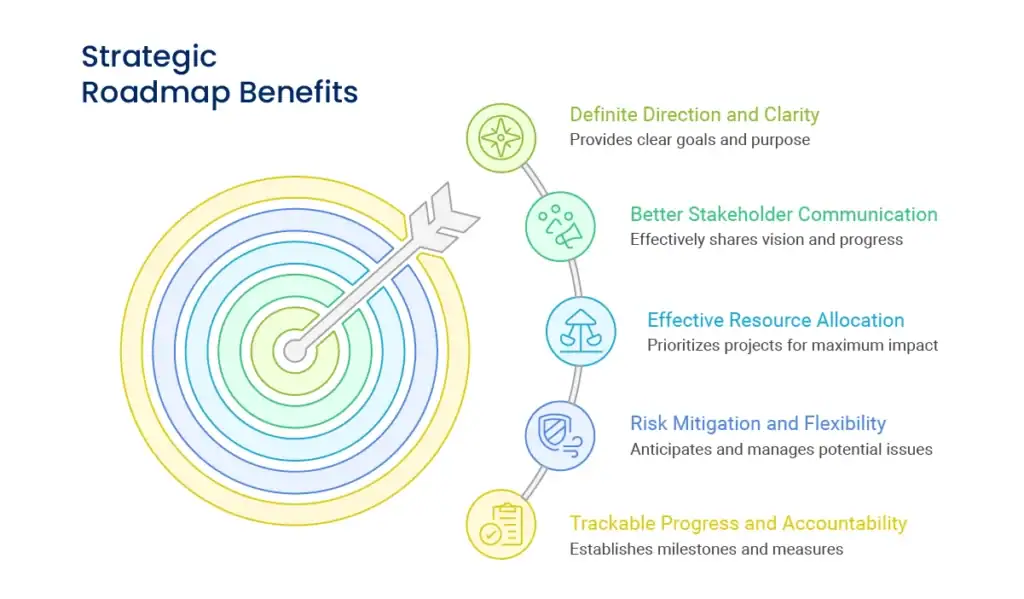
Your roadmap takes the guesswork out of day-to-day operations. When your team truly understands what they are working towards and why, productivity increases naturally. No more wondering whether or not that new project is in line with company objectives or if resources are being utilized efficiently.
Regardless of whether you're addressing investors, reporting to your board, or inspiring your staff, a clearly written strategic roadmap speaks effectively to your story. You can easily communicate your vision to stakeholders, how you intend to get there, and monitor progress in between.
Limited budget and time demand wise decisions. Your strategic plan enables you to prioritize projects according to the influence they have on your overall objectives. It keeps you away from the tendency of agreeing to do everything and becoming too diluted.
Strategic roadmaps enable you to predict potential issues before they escalate into crises. By planning out dependencies and possible problems, you are able to create contingency strategies and engineer resilience into your operations.
Trackable Progress and Accountability Without defined milestones and measures, you can’t possibly know whether your strategy is succeeding or not. Strategic roadmaps establish accountability throughout and provide you with the information you need to make smart adjustments.
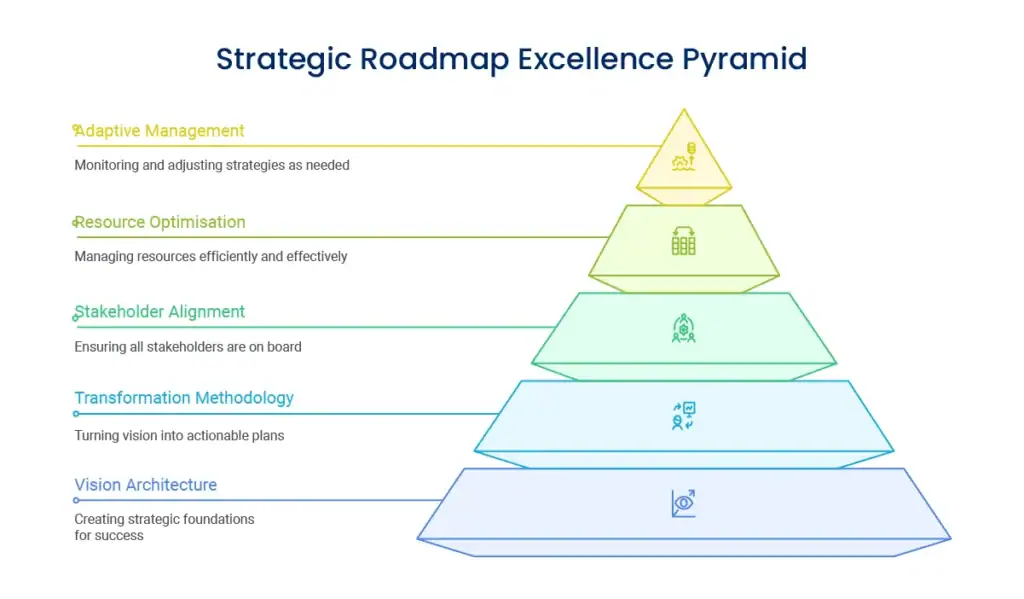
Your strategic plan starts with a clear-as-day vision that will be your north star. It’s not a mission statement that’s all warm and fuzzy – it’s a precise, quantifiable explanation of what success is for your organisation.
Begin by crafting your 3-5 year vision in tangible terms. Rather than generalities such as “be the best in our industry,” define specific results: market share, revenue levels, customer metrics, and operational capabilities you intend to attain.
Your vision framework should also encompass your strategic principles and core values. They serve as guardrails, causing you to make choices that remain authentic to your brand character even as market dynamics shift.
The sorcery occurs when you segment your high-level vision into bite-sized bits. Your transformation methodology must have a well-defined hierarchy: strategic themes, initiatives, projects, and tasks.
Strategic themes are the broad topics that will propel your vision. The majority of successful organizations will have 3-5 strategic themes that encapsulate the nature of their strategy for growth. Typical themes are market growth, operational excellence, customer experience, or digitalization.
Every strategic theme includes several initiatives – discrete programmes of work that get you closer to your objectives. Initiatives must be big enough to need dedicated resources and focus, but not so large they are impossible to handle.
Your strategic guide only succeeds if everyone knows and supports the plan. That involves intentional communication strategies directed at various stakeholder groups.
Leadership groups must be able to understand how the roadmap aligns with business goals and resource needs. Heads of departments need to know how their staff are contributing to achieving strategic success. Front-line staff must understand how what they do each day fits into larger strategic goals.
Develop several versions of your roadmap intended for various groups. The executive summary can include high-level themes and dollar amounts, and departmental roadmaps detail specific tasks and schedules.
Intelligent allocation of resources differentiates effective strategic roadmaps from daydreaming. You require realistic estimates of what your organisation can realistically do based on existing capabilities and limitations.
Begin by listing your resources at hand: financial budget, human capital, technology infrastructure, and external partnerships. Next match them against your strategic initiatives to delineate gaps and interdependencies.
Priority management becomes an absolute necessity when you understand you can’t do everything simultaneously. Utilize tools such as the MoSCoW method (Must have, Should have, Could have, Won’t have) to prioritize initiatives based on their feasibility and impact.
Your strategic roadmap needs built-in measurement systems to track progress and identify when course corrections are needed. This goes beyond simple project status updates – you need metrics that show whether your strategy is actually working.
Create key performance indicators (KPIs) for every level of your roadmap. Strategic themes must have general success metrics, while individual initiatives require specific performance indicators. Balance leading indicators (predictive indicators) with lagging indicators (outcome indicators) to receive both early warning signs and ultimate outcomes.
Periodic review cycles make your roadmap current and adaptive. Project progress is monitored by monthly operation reviews, quarterly strategic reviews measure initiative performance, and annual strategic planning meetings review and renew your overall direction.
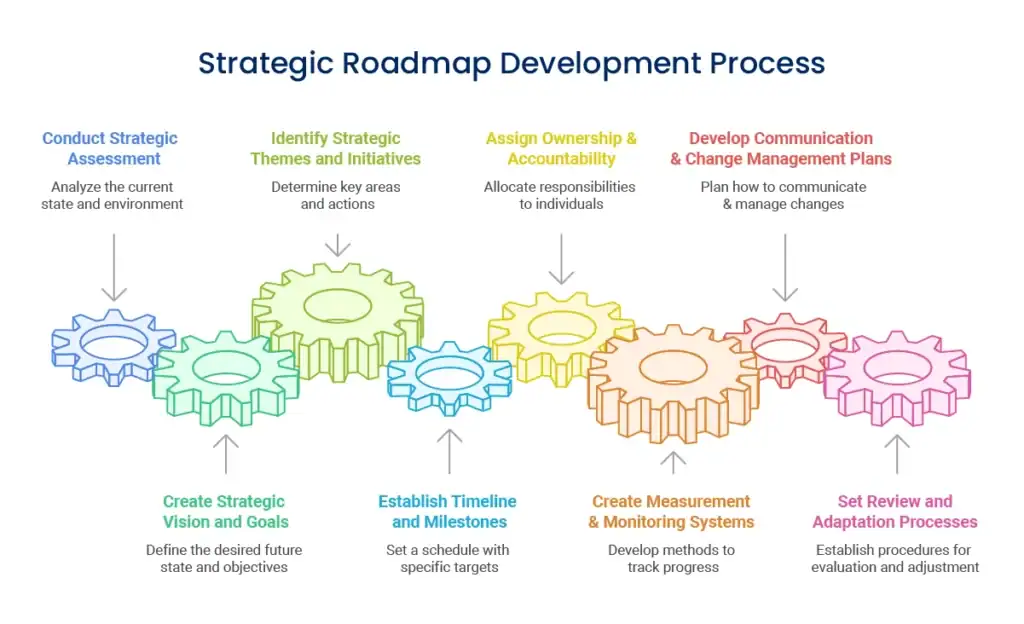
Begin with a thorough analysis of your current situation. This includes internal capabilities assessment, competitive landscape analysis, and market trend evaluation.
Use frameworks like SWOT analysis (Strengths, Weaknesses, Opportunities, Threats) to understand your starting position. But don’t stop there – dig deeper into customer needs, technological disruptions, and regulatory changes that might affect your strategy.
Involve stakeholders at every step along the way. Their perspectives often uncover blind spots and ensure that your roadmap targets actual difficulties instead of assumed ones.
Translate your assessment findings into a strong vision for success in the future. Your vision must be specific enough to inform decisions but malleable enough to change as conditions do.
Break your vision down into 3-5 strategic goals that represent broad areas of focus. Each goal must be measurable, time-specific, and specifically linked back to your overall vision.
Test your vision and goals with key stakeholders to guarantee alignment and buy-in. This keeps expensive misalignments from developing later on in the process.
Plot your strategic goals to detailed themes that will inform your work for the planning cycle. There should be 2-4 significant areas of work underneath each theme that need continuous focus and resource allocation.
List 2-4 significant initiatives underneath each theme that will be responsible for taking the organization towards your goals. These initiatives must be substantial enough to warrant individual project management but specific enough to have achievable success standards.
Check each initiative against your organisational capabilities and resource constraints. It’s more important to accomplish fewer things extremely well rather than diluting yourself across too great a set of priorities.
Each initiative in your strategic plan must have an evident owner who owns delivery and outcomes. Ownership should be granted to those with authority and resources required to make decisions and push forward.
Set up governance vehicles that enable initiative owners without bringing bureaucracy overhead. Check-ins, escalation paths, and decision-making processes keep all moving along nicely.
Implement clear communication processes so initiative owners can work together effectively and exchange learnings across the org.
Build end-to-end measurement systems that monitor progress and impact. These consist of project delivery metrics, business outcome indicators, and measures of strategic goal achievement.
Select measures that motivate the correct behaviors and draw attention to most critical things. Don’t experience metric overwhelm by settling on 3-5 key measures for each level of your roadmap.
Place regular reporting and reviewing cycles on-going to keep all stakeholders informed and accountable. Reviews should commemorate achievements, discuss the challenges, and make changes necessary to stay on track.
Your strategic plan must have on-going communication to sustain the momentum and interest. Develop specific messages to be communicated to various stakeholder groups that will best highlight appropriate progress and future changes.
Manage change proactively by assisting individuals in comprehending how the roadmap impacts their job and responsibilities. Offer training and mentoring to assist teams in building new skills needed for success.
Celebrate milestones and achievements along the way to sustain morale and illustrate the worth of your strategic plan.
Incorporate recurring review cycles in your roadmap management process. Monthly operations reviews concentrate on project delivery and short-term issues. Quarterly strategic reviews evaluate initiative performance and market conditions.
Develop guidelines for when and how to change your roadmap to reflect changed circumstances. This involves introducing new initiatives, changing ongoing ones, or terminating activities no longer contributing to your strategic objectives.
Document lessons learned along the way in order to enhance your strategic planning skills over time. Your roadmap cycle needs to leverage the insights and experience gained from earlier work.
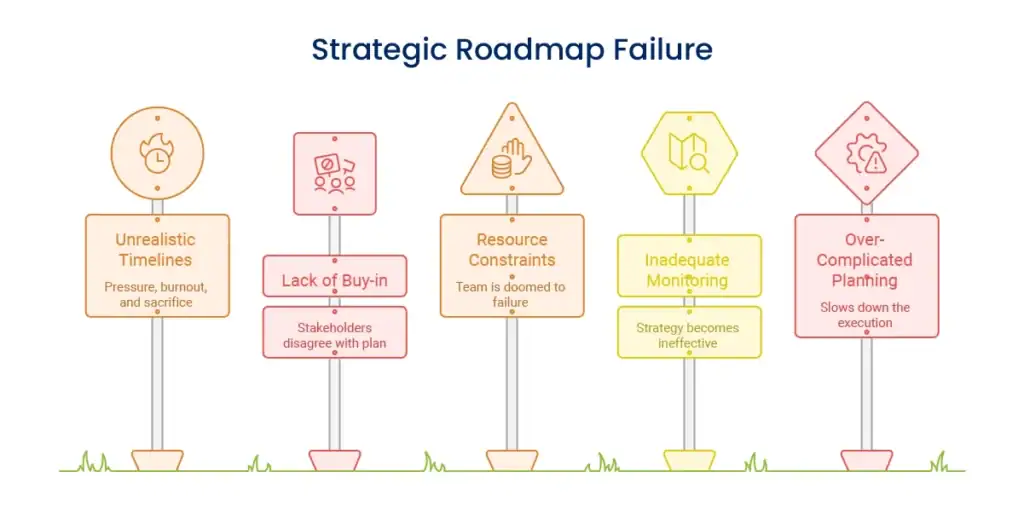
Solutions such as Lucidchart, Miro, and Microsoft Visio facilitate visual maps of your strategic roadmap. These solutions allow collaborative planning sessions and facilitate easy updating and sharing within your organisation.
Platforms like Monday.com, Asana, or Microsoft Project form the execution foundation for monitoring initiative progress and resource distribution. They bridge your overall strategy to every-day implementation.
Business intelligence and analytics platforms such as Tableau, Power BI, or Google Analytics enable you to track strategic KPIs and pinpoint trends that may necessitate roadmap changes. These platforms turn raw data into actionable intelligence.
Pre-existing templates from institutions such as the Balanced Scorecard Institute or Strategy&’s strategy toolkits offer standardized methods for strategic planning process construction. These templates are time-saving and prevent you from overlooking essential aspects.
Cohort analysis classifies customers into categories by common traits or by time, uncovering how behavior trends differently over time. You may learn that customers who were bought in January have greater lifetime values than those bought in June, which means you have seasonal patterns that will determine how you target your marketing efforts.
Follow cohorts on their entire path to determine patterns in conversion timing, purchase amounts, and retention. This time-based view anticipates customer behavior and maximizes acquisition tactics.
Buy-in Strategic roadmaps fail when important stakeholders aren’t aware of or in agreement with the plan. Spend time initially on communication and engagement to get buy-in from all parties on priorities and expectations.
Building ambitious roadmaps in a way that ignores resource constraints dooms your team to failure. Be frank about what you can do with budget, people, and technology you have.
Strategic roadmaps are not “set and forget” maps. The market evolves, priorities evolve, and new opportunities present themselves. Ongoing review and flexibility ensure your strategy remains current and effective.
Complicated planning processes can freeze decision-making and slow the execution. Make your strategic roadmap simple so everyone can comprehend and make the most use of it.
Conversion funnel optimisation directly connects to revenue growth through systematic improvement of key conversion points.
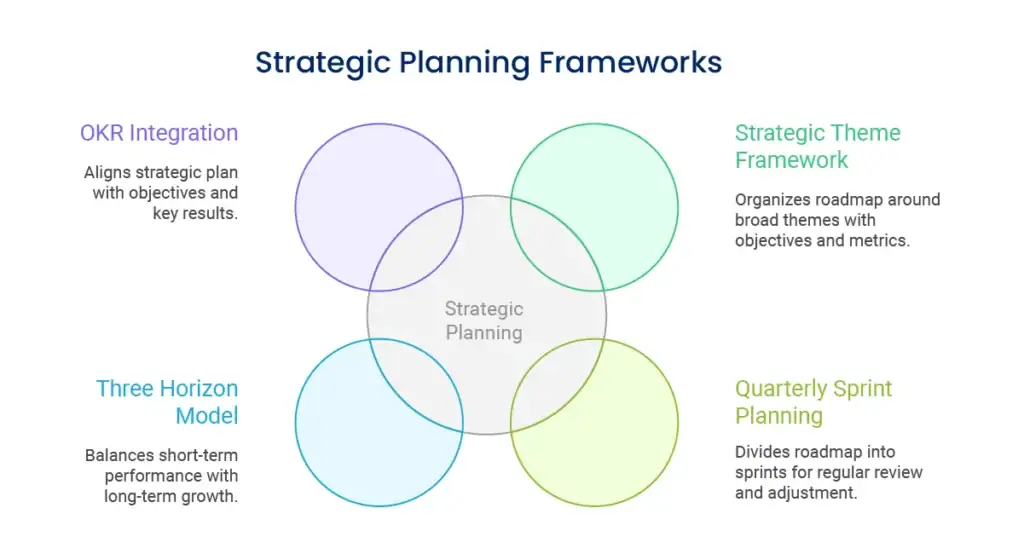
Organize your roadmap in terms of 3-5 broad themes that reflect your strategic priorities. Each of them should have well-defined objectives, success metrics, and resources assigned. This maintains focus while providing flexibility of how you will get there.
Adapt agile methodology principles to strategic planning by dividing your roadmap into quarterly sprints. Each sprint includes certain deliverables and criteria for success, enabling regular review and adjustment.
Balances short-term performance, future emerging opportunities, and long-term transformation by distributing resources over three time horizons. The model makes sure that you don’t jeopardize future growth in favor of short-term results.
Align your strategic plan to Objectives and Key Results (OKRs) technique to establish transparency of accountability and measurement at each organisational level. The method connects individual performance to strategic accomplishment.

Contemporary strategic roadmaps need to consider fast-changing technology environments and digital transformation opportunities. This demands short-term technology needs versus longer-term digital strategy objectives.
Begin by evaluating your existing technology capacity and potential gaps that could constrain your strategic choices. Think about how future technologies such as AI, automation, and data analytics could enhance or undermine your business model.
Create technology roadmaps that support your overall strategic focus. These should rank investments according to their potential for impact on customer experience, operating efficiency, and competitive distinction.
Develop digital capabilities incrementally instead of trying large-scale transformation all at once. Concentrate where technology can do the most to enhance your strategic goals.

Your strategic plan must have contingency planning for possible interruptions and crisis situations. This is not a call to write elaborate plans for every conceivable issue, but rather incorporate flexibility and resiliency into your strategy.
Document critical dependencies and single points of failure in your strategic plans. Establish alternative strategies or contingency plans for high-risk aspects of your roadmap.
Develop scenario planning exercises to challenge how your plan could perform under varying future circumstances. This identifies areas of weakness and potential improvement.
Create operational and financial cushions into your resource planning so you have flexibility when unexpected difficulties emerge. Having reserve capacity enables you to react fast to opportunities and threats alike.
Create well-defined decision-making procedures for emergencies so your staff can respond promptly without holding out for long approval chains.
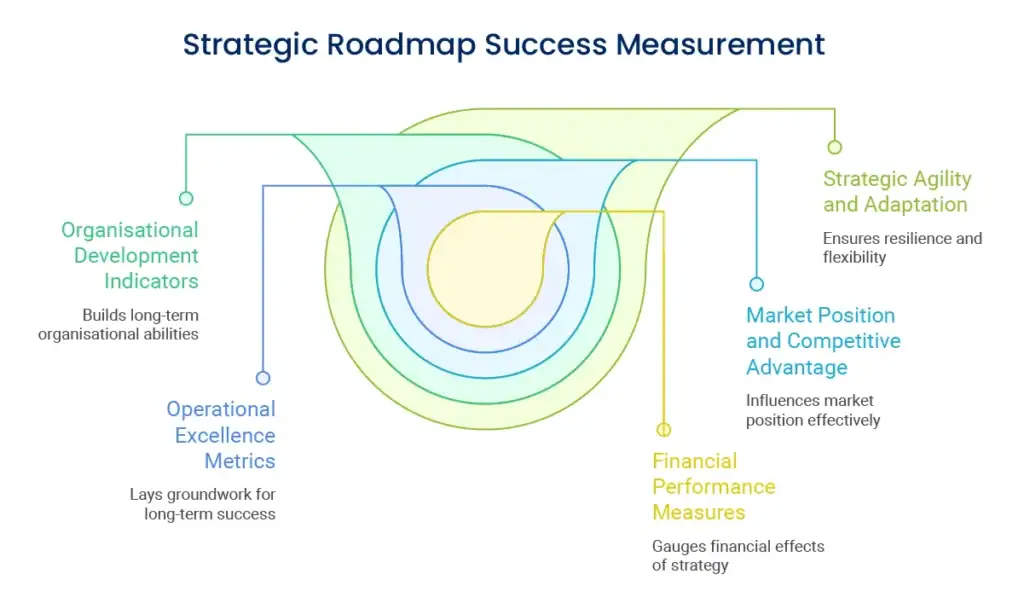
Strategic roadmaps are only as effective as your organisation’s capacity to deliver on them consistently. This means building execution capability in tandem with strategic planning capability.
Invest in building project management capability across your organisation. All team members should know how to work out the plan, manage resources, and deliver on time and budget.
Develop feedback loops that tie execution experiences back to strategic planning processes. Teams must share on a regular basis what they are learning about what works and what doesn’t.
Invest in strategic thinking skills development for your people through training, mentoring, and exposure to strategic decision-making processes. The more your team knows about strategy, the better they will execute it.
Recognize and reward execution excellence to enforce the behaviors and attitudes required for success on strategy. Celebrate both the important milestone accomplishments as well as the quality of execution on a daily basis.
Content marketing and communications approaches are important in sustaining execution momentum through keeping all engaged and informed.
Your strategic guidebook must change as your organisation grows and circumstances in the market evolve. Balancing stability with flexibility to stay relevant over the long term is a must.
Regularly review your planning strengths and seek ways to refine your process and tools. Every planning period should reflect lessons learned from past experience.
Develop relationships with external experts, industry specialists, and peer organizations to bring new thinking to your strategic path. External advice tends to reveal blind spots and new possibilities.
Reflect on how your strategic plan is aligned with wider industry trends and social shifts. Effective organizations see ahead of changes in customer expectations, regulatory needs, and competitive landscapes.
Grow your next generation of strategic leaders by engaging them in roadmap development and implementation processes. This develops organisational capability and provides continuity of strategic thinking.
Good brand strategy development needs to be embedded within your long-term strategic development to ensure consistency between your strategic direction and brand position.
Success measurement against strategic roadmaps necessitates both quantitative measures and qualitative evaluations of progress toward your vision.
Monitor revenue growth, profitability gains, and return on strategic investments to gauge the financial effects of your roadmap implementation. These lagging measures indicate if your strategy is generating value.
Track efficiency gains, quality enhancements, and capability building to measure how effectively your organisation is implementing strategic initiatives. These metrics show you if you’re laying the groundwork for long-term success.
Measure changes in market share, customer satisfaction enhancements, and competitive differentiation to see how your strategy influences your market position.
Get an assessment of employee engagement, skills development, and cultural alignment to ensure that your strategic plan is creating organisational abilities for long-term success.
Determine how nimbly and promptly your organisation adapts to emerging opportunities and threats. This reveals whether your strategic plan is creating resilience and flexibility.
Successful sales funnel analysis calls for strong technology infrastructure which gathers complete data while delivering actionable recommendations.
For bigger organisations, treat your strategic plan as a portfolio of projects with varying risk profiles, timeframes, and resource needs. Balancing short-term results with longer-term growth investments will be easier.
Have adaptable resource allocation procedures capable of reacting speedily to new priorities and opportunities. This could involve quarterly budget reviews and initiative priority exercises.
Develop specialized teams that span organisational lines to implement strategic actions. They combine various expertise and viewpoints while staying focused on strategic results.
Incorporate partnership strategies and external relationships as part of your strategic roadmap. Most successful strategies are based on successful collaboration with suppliers, customers, and strategic partners.
Strategic roadmaps for formulating business strategy should take into account how partnerships may expedite attainment of strategic goals.
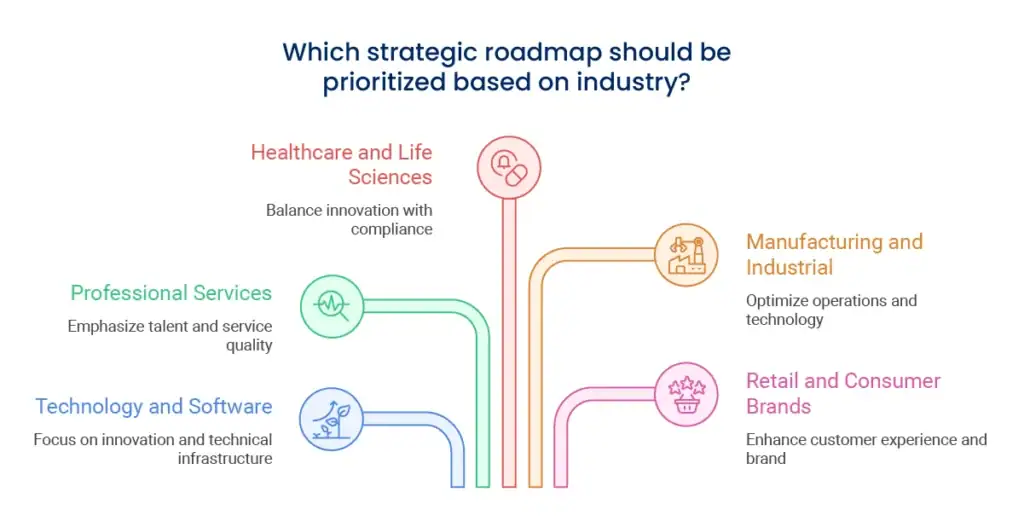
Prioritize aggressive iteration cycles, constant innovation, and platform thinking strategies. Your strategic roadmap should harmonize feature development with investments in technical infrastructure.
Prioritize talent building, service delivery excellence, and client relationship management in your strategic roadmap. Think about how you’ll scale expertise and preserve service quality as your business scales.
Account for longer development times, clinical verification, and regulatory compliance in your strategic plan. Your strategy must balance innovation with risk management needs.
Emphasize operational efficiency, technology adoption, and supply chain optimization in your strategic plan. Think about how digital transformation and automation could change your business model.
Prioritise customer experience, omnichannel integration, and brand building in your strategic roadmap. Your road map must cater to both digital and physical touchpoint development.
Successful brand positioning becomes notably critical for consumer-facing businesses implementing strategic roadmaps.
Operating across multiple markets requires strategic roadmaps that balance global consistency with local market adaptation.

Create phased plans for new market entry that test assumptions and develop capabilities incrementally. Your plan should sequence expansion activity to optimise learning and reduce risk.
Take into consideration local regulations, cultural trends, and competitive forces within each market. Include in your strategic map market-specific initiatives as well as global strategic themes.
Share resources, capabilities, and learnings across markets. This could involve global technology platforms, common service centres, or cross-market talent development initiatives.
Ensure brand consistency but enable local market customization. Your strategic plan should detail what aspects of your brand and strategy are the same across markets and what can change.
Develop top-level strategic dashboards that display progress versus key targets and emphasize key decisions or resource requirements. Communications at this level should emphasize strategic results over operational specifics.
Create recurring communications programs that enable team members to know how their work supports strategic success. These are town halls, team meetings, and one-on-one performance conversations.
Reflect on how your strategic roadmap influences customer communications and market positioning. Align your external communications with your internal strategic direction.
For companies that have external stakeholders or investors, establish communications that show strategic advance and build confidence in your direction.
Strategic brand management concepts should direct how you disseminate your strategic plan to various stakeholder groups.
Even the most well-meaning conversion funnel optimization attempts can fail if you steer clear of these pitfalls:
Governance Structure Design Define clear governance structures that enable strategic decision-making without adding bureaucratic overhead. This can include steering committees, review meetings on a regular basis, and escalation processes.
Risk Identification and Mitigation Systematically list risks that may derail your strategic plan and identify mitigation strategies. These include both external risks (market fluctuations, competitive threats) as well as internal risks (resource limitations, capability gaps).
Decision-Making Processes Establish well-defined processes for making strategic decisions, particularly when situations necessitate deviations from your roadmap. Identify who makes which kind of decision and how information travels in your organisation.
Performance Management Integration Connect individual and team performance management to strategic roadmap execution. This ensures accountability and reinforces the importance of strategic success.
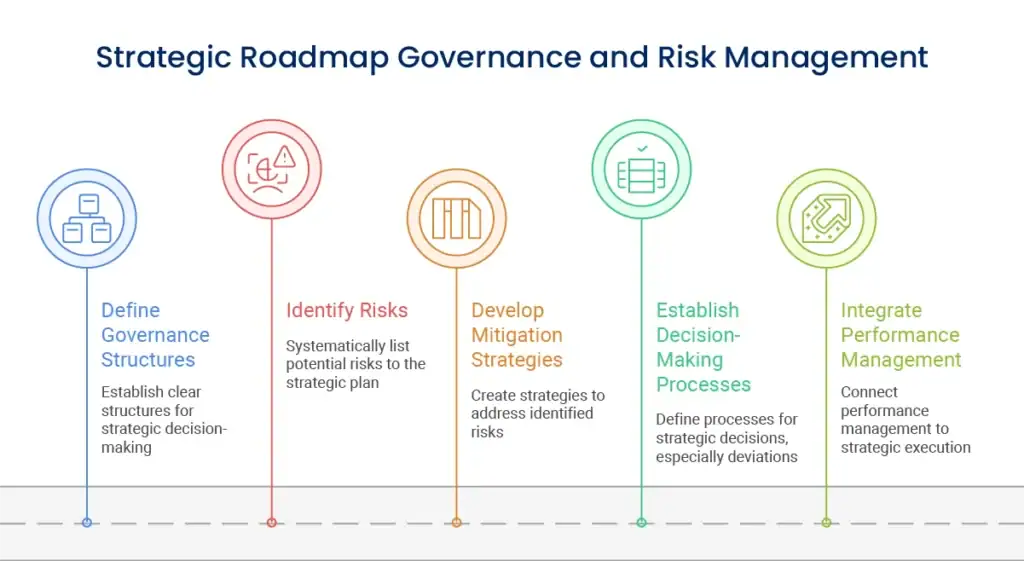
Strategic roadmap creation continues to improve as organisations learn from experience and adjust to shifting business climates.
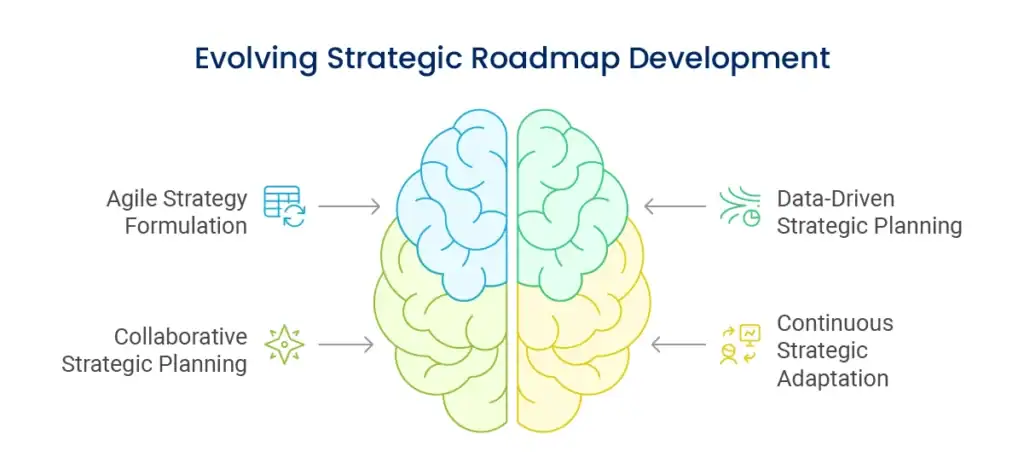
Most organizations are embracing more agile forms of strategic planning with shorter cycles and more frequent updating in response to market feedback and performance data.
More advanced strategic analysis and scenario planning are becoming possible with advanced analytics and artificial intelligence. Organisations are increasingly able to model different scenarios and test strategic assumptions.
Online collaborative tools facilitate more participative strategic planning processes that involve stakeholders that span geographical and organisational distances.
leading organizations are abandoning traditional strategic planning cycles once a year for ongoing strategic monitoring and adaptation processes with rapid response to evolving conditions.
Best-performing organizations revisit their strategic roadmaps quarterly to make operational changes and do full updates yearly. Changes in the market or competitive environment could call for more frequent updates, though. The balance is staying current without constant change that keeps your team confused.
Three to five years offers the optimal balance between long-term perspective and pragmatic planning horizons. Timeframes shorter than this don’t enable strategic initiatives to ripen, yet longer than this becomes too ambiguous for effective planning. Again, this may differ by industry and business cycle conditions.
Establish precise strategic principles and goals that do not change but provide flexibility in the manner in which you pursue them. Employ quarterly reviews to measure performance and make tactical changes without altering your overall direction. This strategy enables focus with responsive adaptability to emergent opportunities and challenges.
Designing and implementing successful strategic roadmaps demand both analytical acumen and hands-on experience. If you are ready to turn your vision into concrete plans that fuel sustainable growth, our team excels at assisting organisations in designing and implementing strategic roadmaps that work.
Mastering strategic roadmaps turns visionary into actionable business achievement. Using the frameworks and steps described here, you can close the gap between where your organisation is now and where you would like it to be tomorrow.
The most effective strategic roadmaps reconcile bold vision and practical planning, sustain stakeholder alignment through implementation, and evolve to respond to changing circumstances without sacrificing basic strategic tenets. They are living documents that inform every day’s decisions and long-term investments toward tangible business results.
Your strategic blueprint is not just a planning report – it’s the source for creating a strong, nimble organisation that succeeds no matter what the market does. Begin with unambiguous vision architecture, build sound transformation practices, and execute disciplined practices that translate strategic intent into competitive success.

Enter your email to get instant access